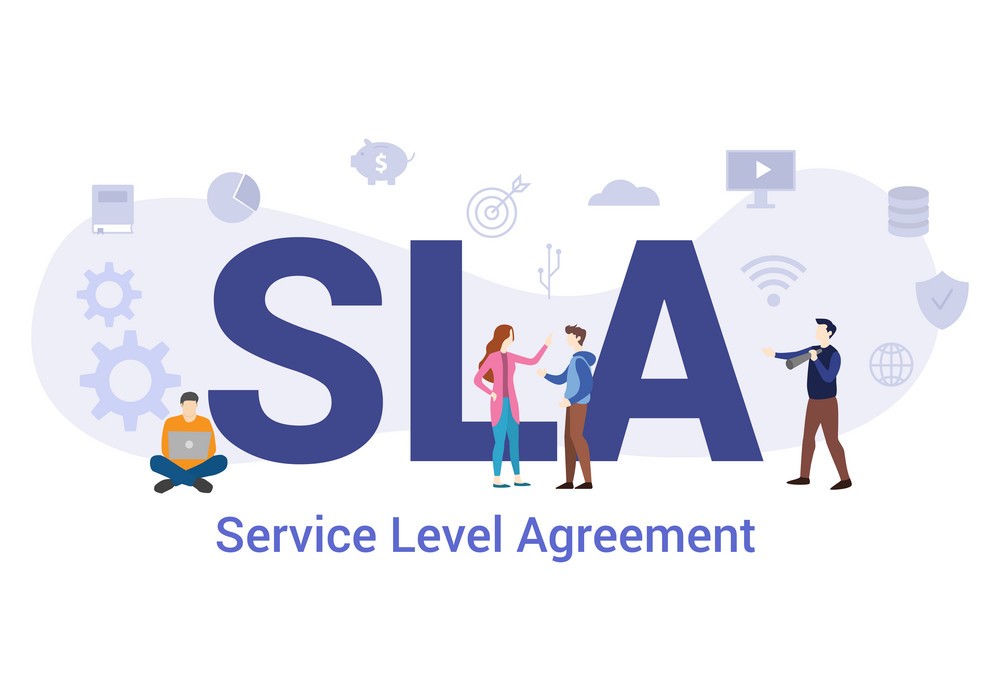Service-Level Agreements (SLAs) — A Comprehensive Guide
In the realm of business relationships, uncertainties, miscommunications and unfulfilled commitments can arise among customers, service providers and internal departments. Service-Level Agreements (SLAs) serve as a powerful tool to mitigate these challenges and establish clear expectations from the outset.
While SLAs might seem complex, this guide aims to demystify them, providing you with the knowledge to navigate the world of SLAs proficiently. We will cover:
- What is a Service-Level Agreement (SLA)?
- Who Needs an SLA and Why?
- How SLAs Work
- Types of SLAs
- SLA Best Practices
- Examples of SLAs
- FAQ for SLA
What is a Service-Level Agreement (SLA)?
SLAs specify the level of services a customer can expect from a supplier or vendor. It outlines the expected services, metrics for measurement and penalties for non-compliance. SLAs are not only a mutual agreement between vendors and the companies they supply but also can be internal, between different departments within a company.
Vendors such as Adobe, Google, Amazon Web Services and Microsoft etc. use SLAs to provide details about guaranteed interface availability, expected server downtime and customer compensation for service disruptions.
Who Needs an SLA and Why?
Documenting expectations and metrics in an SLA ensures a shared understanding between parties to prevent disputes over failed deliverables or underperformance/unavailability of services. Internal SLAs within companies help avoid misinterpretation and miscommunication between departments.
Key Benefits of SLAs:
- Improve Customer and Employee Experiences: Microsoft Clarity enhances customer’s experience and internal job satisfaction.
- Better Alignment: Provides a common reference, reducing friction between parties.
- Clear Metrics for Success: Defines key performance indicators (KPIs) for measuring success.
- Precise Communication: Establishes a structured communication framework to reduce the need for clarifications.
- Optimized Productivity and Morale: Microsoft Clearly define deadlines and deliverables to enhance focus on priority tasks and boosting confidence in service providers.
How SLAs Work
Every organization's SLA may vary, understanding some fundamental aspects is crucial before diving in.
Party Responsible for the SLA
Most vendors have standard SLA to cover their services, serving as a foundation for negotiations. It's essential to treat vendor's standard SLA as a starting point and customize it to align with your specific needs.
Key Components of an SLA
Critical components to include in an SLA are:
- Overview of the Agreement: Describes the basic terms, parties involved, start date and an introduction to the services provided.
- Services: Specifies deliverables, completion timelines and other capabilities during the agreement's duration.
- Metrics: Define goals and measurement indicators, both from the customers and vendors perspective.
- Points of Contact: List contacts responsible for different aspects of service, ensuring effective communication.
- Exclusions: Describes what is not included in the service agreement.
- Conditions for Cancellation: Outlines terms for terminating the agreement, covering various scenarios and consequences.
- Review of SLA: The goal of reviewing an SLA is to eliminate confusion, so a thorough examination of the details is essential.
The Purpose of an Indemnification Clause
Indemnification is a crucial clause in an SLA, stating that the vendor will indemnify the customer for failure to deliver agreed services. This includes covering legal costs, damages, losses or liabilities resulting from SLA violations. It's advisable to negotiate the scope of indemnification with the supplier.
Types of SLAs
There are three major types:
- Customer Service-Level Agreement: Between a vendor and a customer, ensuring a specific level of service delivery.
- Internal Service-Level Agreement: Defines responsibilities and expectations between different teams within a company.
- Multilevel Service-Level Agreement: Splits SLAs into tiers addressing different customers or departments, covering all relevant aspects.
SLA Best Practices
- Be Realistic and Clear About Goals: Clearly state achievable goals and ensure mutual understanding.
- Be Specific About Details: Include every detail, even if it seems understood, to eliminate ambiguity.
- Define Metrics: Specify metrics for measuring service success, tailored to the nature of the agreement.
- Structure and Clarity: Ensure the SLA has a clear structure, making it easy to follow despite any legal language.
Examples of SLAs
SLA details are unique to each business, but here are examples from major companies:
- Google Workspace: Clearly outlines uptime guarantees and service credit terms for non-compliance.
- Microsoft Azure: Offers separate SLAs for various cloud services, each with specific uptime commitments.
- PandaDoc: Uses a clear and simple structure to outline responsibilities, objectives and limitations.
- Adobe Experience Cloud: Clearly defines terms like availability, downtime and service credits for non-compliance.
Most Frequently Asked Questions
Before consulting legal counsel, consider these FAQs:
1. Is an SLA Transferable?
The transferability of an SLA depends on the acquiring company after a merger. It's best not to assume transferability.
2. What Happens if Service Levels Aren't Met?
Penalties for unmet service levels are outlined in the SLA, usually involving service credits deducted at an agreed-upon rate.
3. What Are "Earn Backs"?
Vendors may include clauses allowing them to earn back service credits lost by performing at or above standard levels for a specific time.
4. How Often Should SLAs Be Revised?
SLAs are dynamic documents and should be reviewed when business needs change, technology evolves, workloads shift or metrics and processes are updated.
Tips for Service-Level Agreements
SLAs, by removing ambiguity, contribute to smoother relationships. Establish expectations, define metrics and use a content management tool to organize and make the SLA readily accessible.
If your company relies on suppliers for services, meet with your team to establish expectations from vendors and the metrics for evaluation. Suppliers, define the scope and accessibility of your services clearly.









